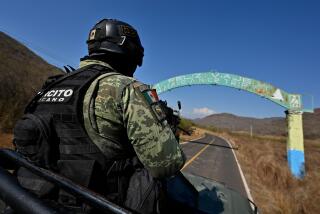Foreign Hand Is Suspected in Baghdad Blasts
WASHINGTON â The four attackers in Mondayâs coordinated series of suicide bombings in Baghdad each detonated 1,000 pounds of plastic explosives, U.S. officials said Thursday, fueling speculation that Al Qaeda or other terrorist networks were behind the new wave of deadly violence in Iraq.
The recent mayhem is believed to have been the first time since the United States occupied Iraq that such sophisticated and powerful explosives -- rather than crude devices with conventional charges -- were used to attack Western targets, according to counter-terrorism experts in the FBI and other government agencies.
Those conclusions, based on an investigation in Baghdad by FBI forensic experts and bomb technicians, escalated concerns that foreign fighters were behind the attacks, including Al Qaeda or Hezbollah operatives trained in the use of such materials.
The explosives âare believed to have originated outside of Iraq,â a senior federal law enforcement official said.
âIt is significant. It does suggest a level of coordination and even possible involvement of very comprehensive terrorist networks like Al Qaeda or even Hezbollah,â another official said. âIt raises a lot of concerns about the nature of the violence and involvement of external forces.â
Several senior counter-terrorism officials cautioned that authorities had yet to see definitive evidence of a significant Al Qaeda or Hezbollah presence in Iraq. Most likely, they said, those responsible for Mondayâs bombings are a mix of foreign fighters, Baath Party loyalists and local Iraqis who resent the presence of U.S. and other Western forces.
However, other tactics used by the bombers also point to the involvement of organized groups such as Al Qaeda or sympathizers who have been well-trained in their methods, the officials added. The tactics include the almost simultaneous timing of the attacks, the use of diversionary tactics to allow the bombers to get close to their targets and the choice of a symbolic day for the attacks -- in this case the first day of Ramadan, the holiest month in the Islamic calendar.
The attacks occurred within 45 minutes on Monday morning at three Iraqi police stations and the headquarters of the International Committee of the Red Cross. In all, at least 35 people were killed and more than 200 injured in the deadliest day of violence in the capital since U.S. forces drove President Saddam Hussein from power.
American officials said late Thursday that they were continuing to investigate how and when the explosives were smuggled into Iraq and whether they were linked to the disbanded Iraqi military.
A senior FBI official said that so far, nothing had been gleaned from the attacks that would definitively link them to Al Qaeda or Ansar al Islam, an affiliated Iraq-based Islamic terrorist group, or to the remnants of Husseinâs military and security forces. However, a senior defense official confirmed that Izzat Ibrahim, a top Hussein advisor who remained at large, was believed to be coordinating anti-U.S. activities between Baath Party loyalists and outside groups, including Ansar.
âThereâs not much we can say at this point about it, except that these are nothing like the usual Soviet-made explosives used in all of the other attacks,â another senior FBI official said. âWhat it means, we donât know at this point.â
The U.S. officials said they were particularly concerned that Ansar members were providing safe haven and logistical support to the estimated 1,000 to 3,000 foreign Islamic fighters believed to be in Iraq, making it all but impossible to gather intelligence on who, exactly, was responsible.
âThe threat has moved beyond Al Qaeda to other groups that are trained and financed by Al Qaeda,â agreed Rohan Gunaratna, a counter-terrorism consultant based at the Institute for Defense and Strategic Studies in Singapore. âAnsar al Islam is the main one, but other fighters are there too, using the infrastructure of the Baath Party. It is an unholy alliance.â
More to Read
Sign up for Essential California
The most important California stories and recommendations in your inbox every morning.
You may occasionally receive promotional content from the Los Angeles Times.









